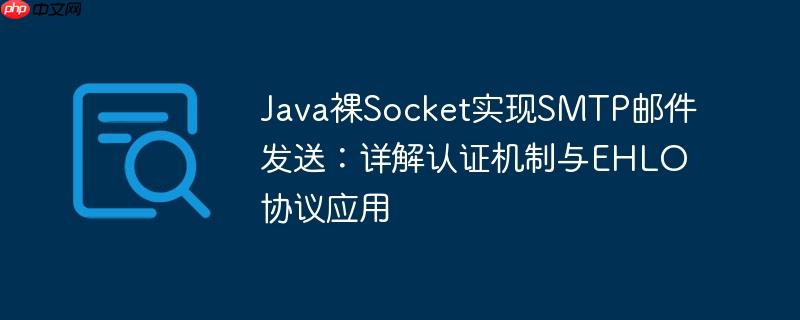
当尝试使用裸socket连接smtp服务器发送邮件时,一个常见的错误是收到“530 5.5.1 authentication required”响应。这通常不是tls/ssl加密本身的问题,而是因为现代smtp服务器要求客户端进行身份验证才能发送邮件,以防止垃圾邮件和滥用。
原始的SMTP协议(RFC 821)使用HELO命令进行会话初始化,但它不包含任何身份验证机制。为了满足更复杂的需求,如身份验证、更大的邮件尺寸、更灵活的传输编码等,SMTP协议被扩展为扩展SMTP (ESMTP)。ESMTP使用EHLO命令替代HELO,服务器在响应EHLO时会列出其支持的所有扩展,其中包括认证机制(如AUTH PLAIN、AUTH LOGIN等)。
因此,要成功发送邮件,客户端必须:
AUTH PLAIN是一种常用的ESMTP认证机制,它要求客户端将用户名和密码以特定格式编码后,通过Base64进行传输。其格式为:�username�password。
例如,如果用户名为your_username,密码为your_password,则需要构造的字符串是:�your_username�your_password。然后,将这个字符串进行Base64编码。
立即学习“Java免费学习笔记(深入)”;
生成Base64编码字符串的示例(Linux/macOS命令行):
echo -ne '�your_username�your_password' | openssl base64
将your_username和your_password替换为你的实际邮箱账号和密码。例如,如果用户名为test@naver.com,密码为password123,则输出可能类似于AHlvdXJfY3JlbGVudGlhbHNAZ21haWwuY29tAHlvdXJfY3JlbGVudGlhbHNAZ21haWwuY29t(实际会更长)。
在Java代码中,你需要将这个Base64编码后的字符串作为AUTH PLAIN命令的参数发送给服务器。
下面是一个修改后的Java代码示例,它演示了如何使用EHLO命令和AUTH PLAIN机制来通过SMTP服务器发送邮件。
import javax.net.ssl.SSLSocket;
import javax.net.ssl.SSLSocketFactory;
import java.io.*;
import java.util.Base64; // 用于Base64编码
public class MailClientWithAuth {
// 邮件发送者和接收者
private static final String FROM_EMAIL = "sender@example.com"; // 替换为你的发件邮箱
private static final String TO_EMAIL = "receiver@example.com"; // 替换为你的收件邮箱
// SMTP服务器地址和端口
private static final String SMTP_HOST = "smtp.naver.com"; // 或 smtp.gmail.com, smtp.qq.com 等
private static final int SMTP_PORT = 465; // SMTPS默认端口
// 邮箱认证凭据
private static final String USERNAME = "your_email_username"; // 替换为你的邮箱账号
private static final String PASSWORD = "your_email_password"; // 替换为你的邮箱密码或授权码
public static void sendMail() throws Exception {
String reply;
// 1. 初始化SSL Socket连接
SSLSocketFactory sslsocketf = (SSLSocketFactory) SSLSocketFactory.getDefault();
System.out.println("Connect Start to " + SMTP_HOST + ":" + SMTP_PORT);
SSLSocket socket = (SSLSocket) sslsocketf.createSocket(SMTP_HOST, SMTP_PORT);
System.out.println("Connect Success");
BufferedReader inFromServer = new BufferedReader(new InputStreamReader(socket.getInputStream()));
PrintWriter outToServer = new PrintWriter(socket.getOutputStream(), true);
// 2. 接收服务器初始欢迎消息
reply = inFromServer.readLine();
if (reply == null || !reply.startsWith("220")) {
System.out.println("Server Connect Fail: " + reply);
System.exit(0);
}
System.out.println("Server Connect Success! " + reply);
// 3. 发送 EHLO 命令并检查服务器能力
outToServer.println("EHLO " + SMTP_HOST.split("\.")[0] + ".com"); // 使用域名的一部分作为EHLO参数
reply = inFromServer.readLine();
System.out.println(reply);
// 检查EHLO响应中是否包含AUTH能力
if (!reply.startsWith("250")) {
throw new Exception("EHLO command failed: " + reply);
}
// 读取所有EHLO响应行,直到遇到以250开头的行且后面没有破折号
while (reply.startsWith("250-")) {
reply = inFromServer.readLine();
System.out.println(reply);
}
// 假设服务器支持AUTH PLAIN,这里简化处理,实际应解析响应
// if (!reply.contains("AUTH PLAIN")) {
// throw new Exception("Server does not support AUTH PLAIN: " + reply);
// }
// 4. 进行身份验证 (AUTH PLAIN)
// 构造认证字符串: �username�password 并进行Base64编码
String authString = "�" + USERNAME + "�" + PASSWORD;
String encodedAuthString = Base64.getEncoder().encodeToString(authString.getBytes());
outToServer.println("AUTH PLAIN " + encodedAuthString);
reply = inFromServer.readLine();
replyCheck(reply, "235"); // 235 2.0.0 Authentication successful
System.out.println("Authentication successful.");
// 5. 发送 MAIL FROM 命令
outToServer.println("MAIL FROM: <" + FROM_EMAIL + ">");
reply = inFromServer.readLine();
replyCheck(reply, "250");
// 6. 发送 RCPT TO 命令
outToServer.println("RCPT TO: <" + TO_EMAIL + ">");
reply = inFromServer.readLine();
replyCheck(reply, "250");
// 7. 发送 DATA 命令,准备发送邮件内容
outToServer.println("DATA");
reply = inFromServer.readLine();
replyCheck(reply, "354"); // 354 Start mail input; end with <CRLF>.<CRLF>
// 8. 发送邮件内容
outToServer.println("Subject: Test Mail from Java Socket Client");
outToServer.println("From: " + FROM_EMAIL);
outToServer.println("To: " + TO_EMAIL);
outToServer.println(""); // 空行分隔邮件头和邮件体
outToServer.println("Hello, this is a test email sent from a custom Java socket mail client.");
outToServer.println("This demonstrates SMTP EHLO and AUTH PLAIN authentication.");
outToServer.println("."); // 邮件内容结束标志
reply = inFromServer.readLine();
replyCheck(reply, "250"); // 250 OK, message accepted for delivery
// 9. 发送 QUIT 命令,结束会话
outToServer.println("QUIT");
reply = inFromServer.readLine();
replyCheck(reply, "221"); // 221 Bye
// 10. 关闭资源
outToServer.close();
inFromServer.close();
socket.close();
}
/**
* 检查服务器响应是否以预期的状态码开头
* @param reply 服务器响应字符串
* @param expectedStatus 预期的状态码前缀
* @throws Exception 如果响应不匹配预期状态码
*/
public static void replyCheck(String reply, String expectedStatus) throws Exception {
System.out.println("Server Reply: " + reply);
if (reply == null || !reply.startsWith(expectedStatus)) {
throw new Exception("Unexpected server reply: " + reply);
}
}
public static void main(String[] args) {
try {
MailClientWithAuth.sendMail();
System.out.println("Send Mail Success!");
} catch (Exception e) {
System.err.println("Send Mail Fail");
System.err.println("Error: " + e.getMessage());
e.printStackTrace();
}
}
}重要提示:
通过本教程,我们深入理解了在Java中使用裸Socket实现SMTP邮件发送时,身份验证的重要性。核心在于使用ESMTP的EHLO命令而非HELO,并利用AUTH PLAIN等机制向服务器提交用户凭据。虽然手动实现可以帮助我们理解底层协议工作原理,但在实际开发中,为了提高效率、健壮性和安全性,强烈推荐使用如JavaMail API这样的专业库来处理邮件通信。
以上就是Java裸Socket实现SMTP邮件发送:详解认证机制与EHLO协议应用的详细内容,更多请关注php中文网其它相关文章!

每个人都需要一台速度更快、更稳定的 PC。随着时间的推移,垃圾文件、旧注册表数据和不必要的后台进程会占用资源并降低性能。幸运的是,许多工具可以让 Windows 保持平稳运行。




Copyright 2014-2025 https://www.php.cn/ All Rights Reserved | php.cn | 湘ICP备2023035733号